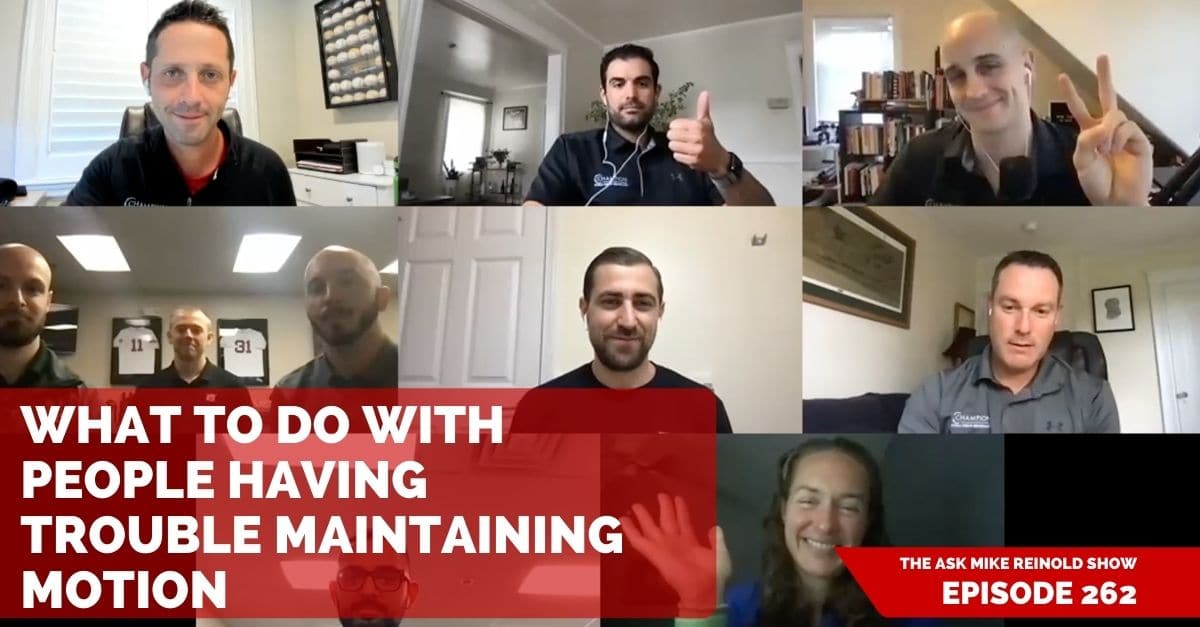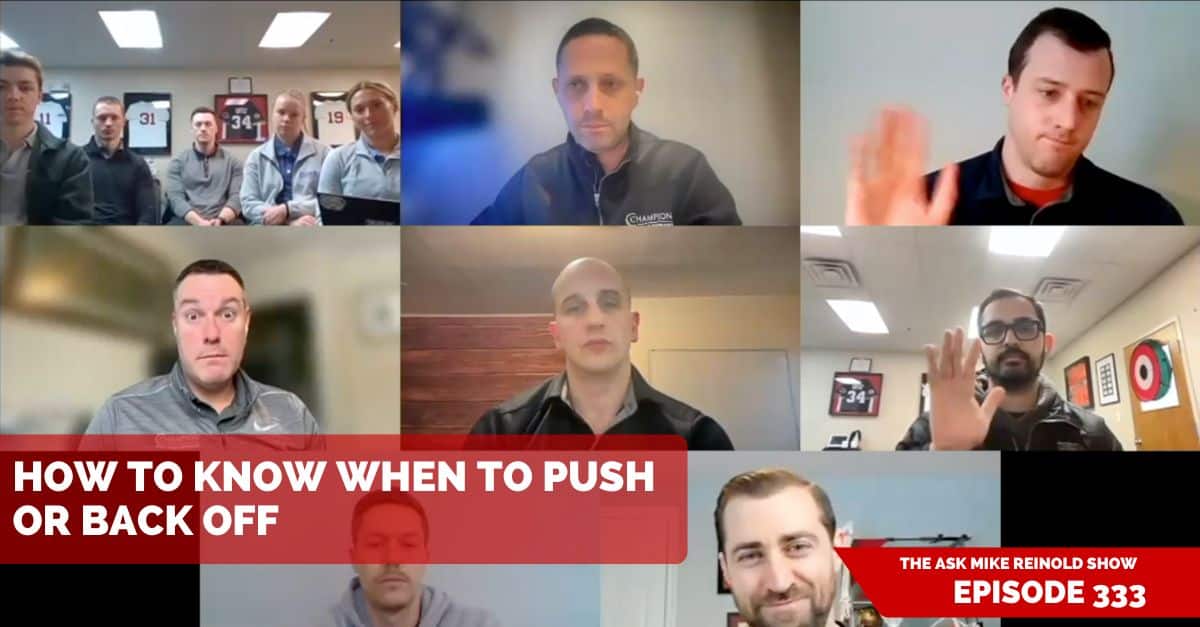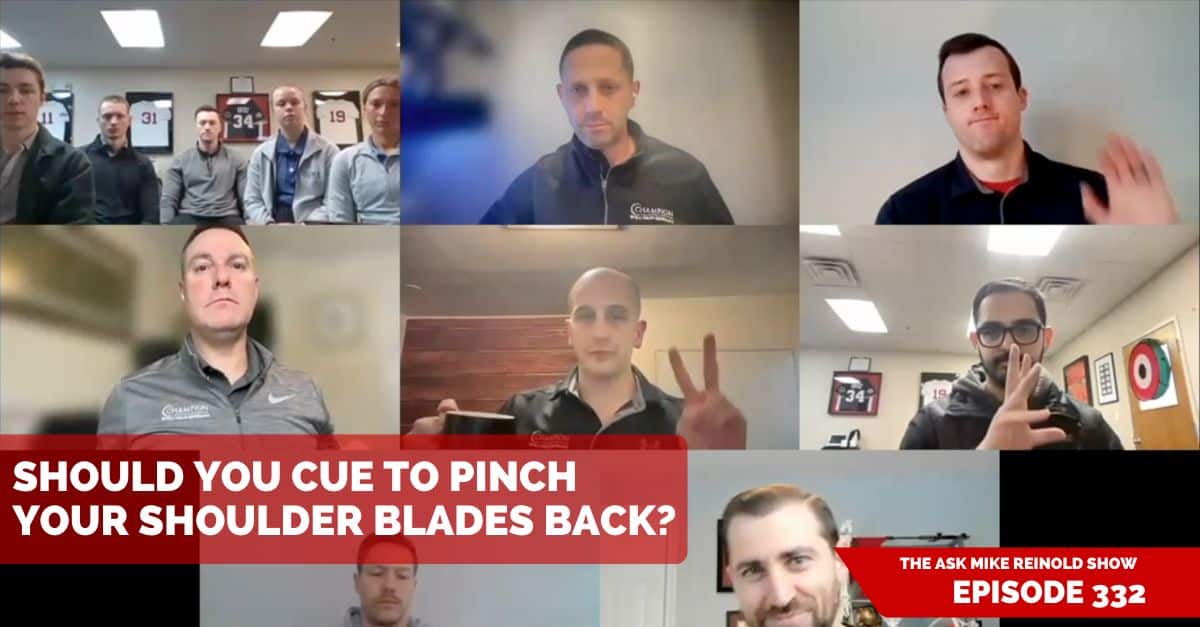It happens to us all, someone we are working with makes great gains in motion, but then returns next time right back where you started.
There could be a few reasons why people don’t maintain their motion gains. Here’s a few of them, and what you can do about it.
To view more episodes, subscribe, and ask your questions, go to mikereinold.com/askmikereinold.
#AskMikeReinold Episode 262: What to Do with People Having Trouble Maintaining Motion
Listen and Subscribe to Podcast
You can use the player below to listen to the podcast or subscribe. If you are enjoying the podcast, PLEASE click here to leave us a review in iTunes, it will really mean a lot to us. THANKS!
Show Notes
- Ankle Mobility Exercises to Improve Dorsiflexion
- 6 Hip Mobility Drills Everyone Should Perform
- The Mobility Episode – Is Too Much Mobility Good or Bad?
Transcript
Chris:
So James from Maryland asks, what would you recommend for a patient having difficulty maintaining the range of motion achieved during PT sessions? They are still waking up in the morning with little to no range of motion and a short time after their PT session, they stiffen up and lose their range of motion gained during the session.
Mike Reinold:
Nice. That’s a good question, James. I mean, that does happen a good percentage of people that have lost some mobility, right. That we see that. And I think that’s probably the one thing that people probably get the most frustrated about as a physical therapist, right? Is that, you’re working with the person, you’re making some gains and then they come back the next day and they’re tight. So, you know, interesting. Who wants to start with this one? This is a good diverse group. Dan, why don’t you start it up while the others gather their thoughts.
Dan:
Kind of curious what he’s talking about, is this like a post-op patient or is this someone who’s just trying to gain mobility for like a sport or something? I guess what I will say is that I think as a profession, we don’t often do the best job of making like an evidence-based stretching protocol or mobility protocol. There’s so many weird ways out there to try to gain mobility. And we do have a decent amount of research about what tends to work and then also the dosage that works. Right. So I kind of compare it to like a diet, people come up to you and say like, “I tried a diet and it didn’t work.” It was like, “Well, did you weigh yourself in the beginning? And then at the end. What’d you eat? Did you eat broccoli? Did you count your calories?”
Dan:
You’re like, “Oh, I didn’t do any of those things.” You know? So sometimes I feel like people don’t have a good protocol that has stretching, let’s say five days a week, 60 seconds, on a given muscle, maybe eccentrics two to three times a week, one to two sets, five to 10 repetitions, and then they need to be able to make sure that they’re measuring at the start and the end. Right. So I think that’s probably the most important beginning is like, make sure you’re measuring. And then on top of that, make sure that you’re applying a good program. And I think the other piece is that you have to wait long enough because a lot of these changes are short-term, right. If I go like this 10 times, bring my arm overhead, I probably just increased my range of motion, but then 10 minutes later, it goes away.
Dan:
If you look at some of this research, people aren’t making a change until it gets to like the four week mark. So part of it, I think is that, it’s kind of like trying to gain muscle mass. You have to look at it that way. It takes a period of time to make these changes. So measure, good program, and then if it’s not changing, then modify, right. I mean, we always do that. If you’re not making the change that you want, maybe to add more, add another exercise, change exercises up and just keep troubleshooting over the course of time.
Mike Reinold:
Nice, good stuff, Dan. And you know that you started that off with kind of talking about like the different types and I think that’s pretty good. I like that. I’m thinking that through a little bit, because I’m trying to think of like all the different types of people we would have with that. But Lisa, what do you think?
Lisa Russell:
Yeah, I mean, I feel like I have a lot of rowers come in that are just like, they have a really hard time getting going in the morning. Right. Cause a lot of us get up early and roll out of bed and just kind of try and move. So the simplest, like less than five minute warm up of just moving your body around and not just [inaudible 00:05:43] backwards has gone a long, long way for a lot of people I’ve worked with. Just cause you know, it has to be short and sweet so that they’re going to do it before they get on the water. And I’ve had a lot of people with back pain or knee pain or hip pain or this or that, just be amazed by what five minutes of just basic mobility and some glute and core activation before they start working out does for them. So I feel like the simple things go a long way more often than I have given credit for in the past.
Mike Reinold:
Right. The simple thing, I think when you educate people that when you try to make it like a part of their life, like Dan kind of said, right, it’s always easier like when you’re in pain, but when you’re not, you just, you fall out of it. Right. Who else wants to jump in?
Lenny Macrina:
I would also say [crosstalk 00:06:39] no, no, no, no, Mike, I speak enough.
Mike Reinold:
Mike’s hand went up first.
Lenny Macrina:
Yes, exactly.
Mike Scaduto:
Yeah. Okay. I definitely have patients that get a little bit stiff, no, I’m just kidding. But if we’re talking about a post-op patient in this question and they’re waking up with little to no range of motion, a short time after PT, I may be taking a step back and wondering if there’s a pretty big inflammatory process going on. Does this person have any underlying immune, auto-immune disorders? If they’re really struggling to regain motion and if they’re losing it, maybe we want to look elsewhere. But my strategy as a physical therapist would definitely be to increase the frequency of motion. I think frequency over intensity. If they’re not working on motion multiple times throughout the day, that would be my first step and probably working on a lesser intensity. So maybe we’re just going to a two to three out of 10 intensity for active assisted range of motion. If they’re still making no progress, then you know, maybe we start considering other factors.
Mike Reinold:
I like that too. And the more flared up and annoying that motion loss is, probably the more frequent, but less intense you want to do it. That’s actually a really good tip. That’s pretty helpful. What do you got Len?
Lenny Macrina:
Well, also I was going to say kind of allude to what Mike said so eloquently. It was amazing how you just worded that, but you got somebody in PT, you do work on their motion. So let’s say, for example, you work for them for an hour, right? One hour is your PT session. There are 24 hours in a day. So they have 23 hours of doing something. If you divide one into 24, you get a number. I think it’s like 5% or something like that. There’s 95% of their day that they need to do something. So they need to do something more frequently, right, like Mike said. So it’s up to you to reinforce the home exercise program, get the moving, easy bouts throughout the day. That’s what I do at my ACL’s, especially to work on knee extension. They are instructed to at least work on four times a day, their knee extension for at least 15 minutes at a time for a 60 minute dose.
Lenny Macrina:
So it’s something similar to that. They need more frequent bouts of a home exercise program, a regimented home exercise program. You got to sell the home exercise program to them, that it’s important. This is why, this is what you need to do, how frequently. And I check in with my people, I texted one of my new ACL patients I had, I texted her on Saturday. She didn’t get back until Sunday because that’s what kids do nowadays. They ignore the text messages and I checked on her to see how she was doing and how she was working on her motion. So it’s little things like that. I think again, to set you apart from other PTs in your clinic or in your area that you are enforcing your programs and that’s going to get you better outcomes and then word spreads and then voilà.
Mike Reinold:
I feel like Lenny, as you’re getting older, you need to adjust to the communication streams of the modern youth. I can’t wait to see you film like a TikTok dance while you’re asking, how is your range of motion? And that, I think I would pay to see that. I think that would be really good.
Lenny Macrina:
We need a Snapchat filter of something, I don’t know.
Mike Reinold:
Is that still cool?
Lenny Macrina:
Instachat?
Mike Scaduto:
I was just going to say, going back to Lenny’s comment, I know we often talk about low load, long duration stretching, particularly in the knee to regain extension, trying to accumulate 60 minutes a day. I will use low load, long duration stretching in other joints as well, particularly in the shoulder. If they’re far enough out of like a labrum repair with a capsular location or a capsular shift, and they’re having trouble regaining external rotation range of motion, I’ll do a low load, long duration stretch into ER, just letting gravity kind of pull their arm back, potentially with a hot pack on the front of their shoulder, trying to get the capsular creek kind of back and regain motion from a capsular perspective. So that’s another strategy that you can try also, you know, bracing and splinting could be something if they are losing all their range of motion and you want to maintain to help supplement your mobility and stretching routine.
Mike Reinold:
Yeah. Especially if they’re really struggling there too. So I guess I would say this, I would say, I think we have to understand the expectation of the specific person in front of us. And I think a lot of people alluded to this in some of their answers. Right. But let’s just talk about like motion as a capacity, right? So if this is like your full capacity of motion, right. And you have an injury, you have surgery and you’re under that capacity, you’re trying to raise it back up to where you were, right. And sometimes surgically or inflammation, et cetera, that becomes a little bit more challenging. That’s the more frequent, less load type motion. I think a lot of people get frustrated when they see somebody completely healthy or pain free. Let’s say like ankle dorsiflexion, they see on one side is less than the other one.
Mike Reinold:
They have no problems and they’re trying to raise their capacity. So not just like get them back up to their baseline, but to get their capacity higher. And I think oftentimes you got to realize like, this is a great example. You have a 65 year old patient with low back pain that can’t touch their toes. I mean, man, they’ve had 65 years of neglect of not being able to touch their toes. I don’t think you giving them a couple of stretches is going to be super impactful on their life. Right. So I think you’ve got to kind of be careful with that sort of thing. I can’t touch my toes. I’ve never been able to touch my toes. I don’t think I’m ever going to be able to touch my toes. Like it just is what it is to some extent.
Mike Reinold:
So if you’re trying to raise somebody’s capacity, I think my expectations are often lower than somebody that’s just trying to get back to their neutral. I would say. Luckily at Champion, I think we see kind of like a hybrid more than anything else. We see athletes that perform a task, right? And this could be anything. It doesn’t have to be an athlete, but you perform a task. And then that task gets you tight. Like that day, you just go throw a ball and you just ran a sprint. Right. And then the next day your arm, your hamstrings are tight. Right. Great. That’s easy. That’s the easiest one for us.
Mike Reinold:
That’s transient tightness that we can address almost immediately and have a very impactful change in that session before they leave. Right. And that’s the one that’s a blast. So don’t confuse that person right, where their hamstrings are tight because they just ran sprints yesterday and you restore their range of motion and it stuck and it lasted right, because they didn’t run again. That’s a great success. Don’t don’t compare that to then a 65 year old with low back pain that can’t touch their toes and you’re struggling to get their hamstrings more mobile.
Mike Reinold:
I just think it’s an unfair fight for you, right. That doesn’t mean you can’t, like Dan said, it’s going to take months. Right. It’s going to take months of hard work to get that going to raise the capacity level. So I think I would just say that, you know, is that not everybody’s the same James and you got to kind of like have realistic expectations for the person in front of you, I guess, based on, on where they are with their motion. Okay. Makes sense. So awesome. Great episode. Good answers from everybody. Thanks everybody. That was awesome. Appreciate it, James. Thanks for submitting that question. If you have one like that, head to mikereinold.com, click on that podcast link, fill out the form, ask away so we can have more chats like this. You know, we really appreciate it. So, but again, we want to see those reviews on iTunes. iTunes, geez. Geez. I’m more out of touch than Lenny. I just said iTunes, right? That’s great. On whatever, what is it? Apple Podcast now. We want to see those reviews on Apple Podcasts, Spotify. Can you do reviews on Spotify?
Mike Reinold:
I lost focus. Anyway, give us some reviews cause we read them and that gives us feedback on our future episodes. So thanks again. I’ll stop talking. See you in the next episode.





